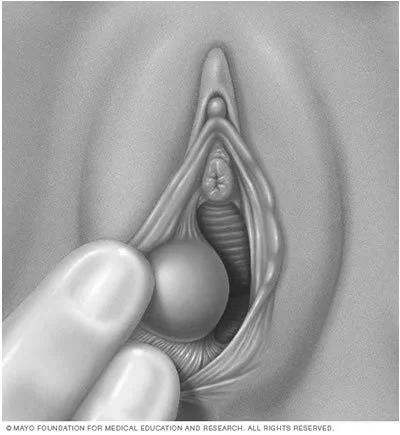About Bartholin glands, cysts, and abscesses
This section is designed to provide information about Bartholin glands and related issues that can develop such as cysts, infections, and abscesses.
Note: There are images of female genitalia further down on this page to show the location of Bartholin glands, cysts, and abscesses.
Glands at a glance
These are quick answers to common questions women will have when they have a Bartholin gland cyst or abscess.
More in-depth information is available on this website.
-
Bartholin glands are a pair of small glands inside the bottom of the labia minora that release fluid through ducts into the vagina. The fluid helps in lubricating the vagina. Normally you cannot feel or see these glands.
-
A Bartholin gland cyst occurs when there is a blockage in the openings of one of these glands (left or right side), leading to the formation of a lump that can sometimes be seen and felt externally (through the labia/vulva) and internally (at the bottom of the entrance into the vagina).
-
A Bartholin gland abscess (BGA) occurs when a Bartholin gland cyst develops a bacterial infection. It forms a lump that can become hard and painful. There can be pain with sitting, sexual activity, or urinating. Rarely, the skin may turn red or a fever may develop.
-
A Bartholin Gland Abscess is very common! It affects 2% of individuals assigned female at birth.
-
Bartholin cysts and abscesses are most common for those under age 30. After menopause, the condition is more rare, but can still occur.
-
A Bartholin gland abscess is due to a bacterial infection and may or may not begin with a cyst. The most common bacterial causes are those normally found on the skin or in the urinary tract. There can be an association with sexually transmitted infections as well, whether from oral sex or intercourse.
Bartholin Cysts & Abscesses
This section has illustrated images of the female genitalia to show where the Bartholin glands are located, and what a Bartholin gland/cyst/abscess looks like.
Bartholin Glands
The illustration shows the female genitalia and the location of the Bartholin glands.
The external parts of the female genitals are called the vulva and include the labia minora and majora. The internal part is called the vagina. Often, people refer to the whole area as the vagina, which can cause some confusion.
Bartholin Gland Cyst
A Bartholin gland cyst is a small fluid-filled sac inside your Bartholin gland.
You have two Bartholin glands - left and right - located inside the bottom of the labia minora (inner labia). Normally, these glands release fluid into the vagina through small ducts and help to lubricate the vagina.
A Bartholin gland cyst occurs when there is a blockage in the openings of one of these glands (left or right side), leading to the formation of a lump that can sometimes be seen and felt externally (through the labia/vulva) and internally (at the bottom of the entrance into the vagina).
This blockage may sometimes be related to friction (rubbing) but often the cause is unknown.
Bartholin Gland Abscess
A Bartholin Gland Abscess is due to a bacterial infection and may or may not begin with a cyst. If you have a Bartholin gland abscess you may experience pain with sitting, sexual activity, or urinating. In some cases, the skin may turn red or you may develop a fever.
If a Bartholin Gland Abscess occurs after menopause, it is usually recommended to obtain a biopsy (sample) to ensure there is no association with cancer. In some places, biopsy is encouraged after age 40.
Is it a Bartholin Abscess?
Swelling in other parts of the vulva (i.e. not the bottom of the labia minora) are not due to a Bartholin Gland Abscess. They may be confused for other types of vulvar abscesses or different conditions such as hidraadenitis suppurativa and vulvar inclusion cysts. The treatment for these may be different than for a Bartholin Gland Abscess

